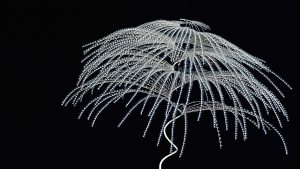The deep sea is the entire ocean below 200 meters in depth. It makes up 95% of Earth’s living space. But only recently, because of technological advances, have scientists been able to explore it and understand its importance.
Scientists believe that as many as 10 million species may inhabit the deep sea – a biodiversity that may be as rich as tropical rainforests. The majority of species are yet to be discovered.
All life on Earth – including human life – depends on the deep sea because it keeps the planet’s systems functioning. It drives the global currents that keep temperatures and weather regulated. It regenerates nutrients. And it absorbs and stores the carbon dioxide emitted into the air by human activity.
Humans benefit from the deep sea in other ways. Deep-sea coral and sponge communities are largely untapped sources of natural products which can be used in medicines, cosmetics and other commercial products. A test being used to diagnose COVID-19 was developed using an enzyme isolated from a microbe found in deep-sea hydrothermal vents.
Vulnerable deep-sea life

The deep sea is the most difficult area on Earth to access: so far, fewer humans have explored its deepest regions than have walked on the moon. But it is also extremely vulnerable, and hard to protect against the impact of human activity.
Most deep-sea species are slow to grow and reproduce, and highly adapted to a largely unchanging environment. This makes them extremely vulnerable to overfishing and other human disturbance. This is recognized by the United Nations General Assembly, which has committed nations to protect the deep sea from harmful fishing activities “recognizing the immense importance and value of deep-sea ecosystems and the biodiversity they contain”.
The deep sea is home to remarkably rich coral systems. Corals were once thought to only inhabit the warm waters of tropical and subtropical regions, but they have actually been thriving in deep, dark and cold waters throughout the world for millions of years. In fact, over half of all known coral species are found in the deep sea. Cold-water reefs are bustling with life, providing essential sanctuaries and nursing grounds for countless other species.
The habitats: plains, vents, corals and seamounts
There are amazing and unique habitats in the deep sea: the abyssal plains, hydrothermal vents and cold seeps and seamounts (underwater mountains). These all have distinct types of life. You can find out more about these on our deep-sea habitats page.
Amazing facts about deep-sea life
- Creatures living near deep-sea hydrothermal vents are unlike any other form of life. They don’t rely on the sun for their energy but on chemicals being pumped from below the Earth’s crust.
- What happens on the deep-seabed affects the ocean surface levels. Deep-sea life supports a complex ocean food web and some twilight-zone inhabitants migrate to the surface to feed every night.
- Approximately 98% of ocean species live in, on, or just above the seafloor.
- Over half of all known coral species live in deep cold waters. Cold water corals can live for thousands of years and grow into beautiful structures that rise 35 meters high.
- Some deep-water fish species, such as the orange roughy, can live up to 150 years.
- Some coral species produce compounds used in antibiotics and painkillers.
- Compounds found in certain deep-sea sponges are potent immunosuppressive and anti-cancer agents.
- Seafans contain substances used to treat asthma and heart disease.
- The female Casper octopus, only discovered in 2016, wraps her body around her eggs on the deep seabed, often onto a manganese nodule– a lump of rock containing some precious metals. The Casper octopus will protect her eggs until they hatch, and often starves to death in the process.
- The recently discovered scaly-foot snail, which lives alongside deep-sea hydrothermal vents, is literally iron-plated – the only known creature that has iron sulphide in its skeleton and shell.
Three ways you are connected with the deep sea
- The air that you breathe
Not only is the ocean responsible for producing half the oxygen we breathe. The deep ocean also stores massive amounts of carbon that would otherwise be in the atmosphere and contributing to global warming.
- Every drop you drink
Water on earth circulates. The deep sea drives water around the earth in a vast current system that rises and falls, regulates temperature and controls our climate. The H2O molecules in your glass of water will have once occupied the deep sea.
- The fish you eat
Many deep-sea fishing fleets use destructive techniques, such as deep-sea bottom trawling on seamounts, to catch long-lived, highly vulnerable deep-sea species such as orange roughy, which end up on the fish counter. Others may use more sustainable practices such as deep-sea handlining in the Madeira and Canary Islands, for example to catch black scabbardfish, a traditional delicacy of Portuguese cuisine. Whether you buy them or not can influence the welfare of the ocean depths.
